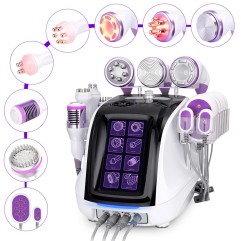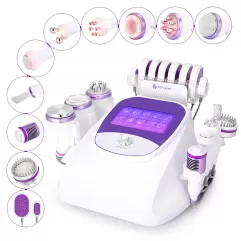Ultrasound cavitation machines are known for their non-invasive nature and have gained popularity for their potential positive effects on the human body. These machines employ thermal and mechanical energy to target localized fat deposits, encouraging natural metabolic processes for body contouring and cellulite reduction without causing adverse effects.
The basic structure of the ultrasonic cavitation machine
A typical ultrasonic cavitation machine has several key components, including an ultrasonic generator, cavitation handle, and control panel. While the specific design and components can vary among different machines, the basic structure typically includes the following components:
Control panel
The machine has a control panel or interface where the operator can adjust and set parameters such as power intensity, treatment time, and mode selection.
Ultrasonic Transducer
The transducer is the key component of the machine that generates high-frequency sound waves. It comprises piezoelectric crystals or ceramic elements that convert electrical energy into mechanical vibrations.
Handpiece or applicator (Cavitation rod)
The handpiece or applicator is the part of the machine that comes into direct contact with the targeted area of the body. It contains the ultrasonic transducer and delivers the sound waves to the desired treatment area. The cavitation rod is a handheld device that emits high-frequency ultrasound waves. It consists of a metallic rod connected to the main body of the ultrasonic cavitation machine. The rod is designed to come into direct contact with the target area of the treated body to remove excess fat.
Safety protection system
To ensure the safety of users and prevent any harm to human tissue, ultrasonic cavitation machines incorporate a vital component known as the safety protection system. This system is designed to include components such as overload protection, short circuit protection, and overheating protection. Its purpose is to automatically halt the operation of the machine when abnormal conditions arise.
Monitoring the machine's temperature and potential thermal sublimation phenomenon is crucial. During operation, the ultrasonic cavitation machine generates heat that must be dissipated through a cooling system to prevent overheating and thermal sublimation. When purchasing the machine, users must ensure the safety protection measures are complete and effective, avoiding any potential safety hazards during usage.
Display:
Many ultrasonic cavitation machines have built-in displays that show relevant information such as treatment settings, treatment time remaining, and energy output levels.
Auxiliary components:
Some machines may have additional components, such as suction cups or massage rollers, and power supply, that can be attached to the handpiece for enhanced treatment effects or to assist with lymphatic drainage.
It's important to note that ultrasonic cavitation machines' exact design and features can vary among manufacturers and models. Therefore, it's advisable to consult the specific user manual or documentation provided by the machine's manufacturer for detailed information on its structure and operation.
Parameters to focus on before purchase
Frequency
While utilizing an ultrasonic cavitation machine, selecting the suitable ultrasonic frequency is essential based on the specific treatment regions and the thickness of the fat layer.
Sound wave frequency, measured in Hertz (Hz), determines the number of cycles produced per second. Ultrasonic cavitation machines operate within the range of 20 kHz to 100 kHz. The frequency chosen depends on the specific tissue type and depth being treated. Lower frequencies can penetrate deeper into the body, but they may be less effective in targeting superficial fat. Conversely, higher frequencies are more suitable for treating superficial fat layers and promoting skin tightening.
Intensity
The term used to describe this concept is power or energy level, which indicates the force of the ultrasonic waves applied to the treatment area. It plays a crucial role in determining the energy transferred to the tissues and affecting the success of the cavitation process.
The intensity can be modified to suit the patient’s comfort and achieve the desired results. Also, it is essential to be aware that higher intensities may raise the potential for negative effects, requiring cautious usage.
Suggested Read: The Best Ultrasonic Cavitation Machines for Home Use - A Comprehensive Guide
Cavitation rod material
The cavitation rod is a vital component of an ultrasonic cavitation machine widely used in aesthetic treatments and body contouring. It plays a crucial role in generating cavitation, as its composition, size, shape, and other factors directly affect its safety measures. The cavitation rod is often equipped with additional features to optimize its functionality. Some rods may include multiple ultrasonic transducers to cover larger treatment areas, while others may incorporate advanced technologies such as RF (radio frequency) or LED (light-emitting diode) therapy for enhanced results.
How to set the appropriate power and frequency according to the different body parts
Before answering this question, let's understand some concepts
Thermal Effect
Ultrasonic cavitation generates heat as a byproduct of the energy tissues absorbs during the treatment. Higher ultrasonic frequencies produce more heat due to increased absorption in the targeted area. While some level of heating is desired for enhancing fat cell disruption, excessive thermal effects can lead to discomfort, burns, or tissue damage. Therefore, the ultrasonic frequency should be carefully selected to balance the desired cavitation effect with acceptable thermal effects.
Optimizing the cavitation effect based on different areas' target depth and size may call for varying frequencies. Varying thicknesses of fat and diverse treatment areas necessitate different output power levels. Higher output power might be required for larger areas with fat layers to achieve the best possible outcomes.
Depth of penetration
Ultrasonic waves exhibit different degrees of penetration into tissues depending on their frequency. Lower frequencies have longer wavelengths and can penetrate deeper into the body. This makes them suitable for treating larger areas or targeting deeper layers of fat.
On the other hand, higher frequencies have shorter wavelengths and tend to penetrate more superficially, making them suitable for treating smaller localized areas closer to the skin surface.
Fat thickness and treatment area
The choice of ultrasonic frequency should consider the thickness of the fat layer and the treatment area. Thicker fat layers may require higher frequencies to achieve adequate cavitation effect, while thinner layers may benefit from lower frequencies to achieve adequate cavitation effect, while thinner layers may benefit from lower frequencies to avoid excessive heating.
Setting the appropriate power and frequency for an ultrasonic cavitation machine depends on the treatment objective, targeted body part, and individual characteristics. The question should be: how should one go about making this choice? Ultrasonic cavitation machines typically offer a range of frequencies and power levels. Lower frequencies penetrate deeper into the tissues but may be less effective for surface treatments, while higher frequencies are more suitable for superficial treatments. The power level determines the intensity of the ultrasonic waves emitted by the cavitation machine. Higher power levels generally provide more aggressive treatment but may also increase the risk of adverse effects.
Here are some guidelines to follow:
- 40 kHz: this frequency is commonly used for fatty tissue treatments, such as abdomen or thighs.
- 80 kHz: this frequency is suitable for treating superficial fat deposits or delicate areas such as the face or neck.
- 1 MhZ: this higher frequency is often used for skin tightening or rejuvenation treatments.
Body part considerations
- Different body parts have varying sensitivities and thicknesses of fatty tissue. Consider the following general recommendations:
- Abdomen and Thighs: start with a lower frequency, for instance, 40 kHz, and gradually increase the power level as needed.
- Arms: A higher frequency, for instance, 80 kHz, can be used along with a medium power level.
- Face and Neck: Use a higher frequency, such as 80 kHz or 1 MHz, with lower power settings to avoid discomfort or adverse effects.
Patient considerations
Individual factors such as skin sensitivity, pain tolerance, and the amount of fatty tissue should be considered when determining the appropriate settings. Adjust the power and frequency based on the patient's feedback and comfort level during the treatment.
Precautions before buying
Equipment brands and manufacturers choose the regular channels to buy
When considering purchasing the ultrasonic cavitation machine, it is important to explore conventional purchasing channels. Evaluating the safety of an ultrasonic cavitation machine involves considering the reputation and capabilities of the brand and manufacturer.
Opting for well-established brands or manufacturers with a proven track record and technical expertise becomes significant. Verify the certification and technical standards of the cavitation machine to ensure compliance with relevant international and domestic regulations.
Notable international technical standards include ISO 13485, IEC 60601, and others, which can serve as safety indicators. You can safeguard their rights and prioritize their safety by avoiding counterfeit and substandard products.
Choose the manufacturer with the perfect after-sales service
Utilizing an ultrasonic cavitation machine entails regular upkeep, maintenance, and possibly encountering malfunctions and issues. When acquiring such a machine, you should opt for a manufacturer that delivers flawless after-sales service, guaranteeing prompt equipment maintenance, training, and other necessary services to ensure uninterrupted machine operation.
Conclusion
Although the weight loss and beauty shaping industry relies heavily on ultrasonic cavitation machines, users must prioritize safety first when considering the machine's parameters to assess its safety and determine the worthiness of the purchase. Power output, frequency range, and treatment modes should be carefully evaluated to ensure a safe and effective user experience. By conducting thorough research and seeking expert advice, you can make informed decisions, guaranteeing the purchase of a safe and valuable cavitation machine.
You may like
-

-

Brand: UNOISETION
10 in 1 Mychway Cavitation Machine Body and Facial Caring for Startup Beauty Studios
$680.00











